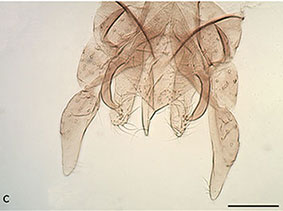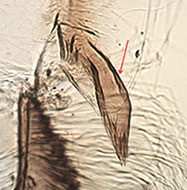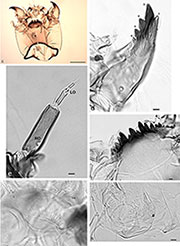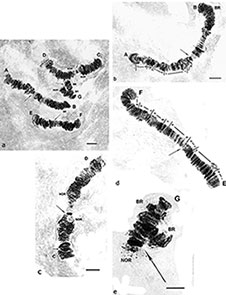Species l. C. alchichica Acosta & Prat 2017.Coloration: Head yellowish brown, thorax dark brown. Abdomen pale brown with dorsal dark markings on TI-VII, wider on TVIII. Legs uniformly pale yellow. Head: AR 3.79 (3.75-3.83); clypeus with 15-20 setae; 30-40 temporal setae. Palps (segs 2-5) 47 : 171 : 189 ; 245; P5/P4 1.30; P5/P3 1.43. Wings transparent without setae, anterior veins pale brown, r-m crossvein and C, M, R1, R4+5 dark brown. Squama with 20-26 setae, 2 SCf on brachiolum. VR 0.94 (0.91-0.95). Leg lengths (micron) and proportions:
Setae on TIX not clear; anal point narrowing to end; Superior volsella of type E of Strenzke 1959); Inferior volsella about to end of anal point, apparently with simple setae. Gonostylus moderately swollen and narrowing significantly over distal third, 6-7 setae at distal end.  Male hypopygium of C. alchichica from Acosta et al. 2017 Female: Not described. Pupa: Length of abdomen 5.4 (4.9-6.2) mm. Cephalic tubercles (males?) conical 145.2-209.7 µm; no mention of frontal warts. Basal ring of thoracic horn 122.4 (107.4- 137.6) µm. Thorax scarcely granular. Abdomen without dorsal shagreen patches evident. Hooks at posterior of segment II continuous but not counted. Pedes spurii B and A well developed on segments II and IV respectively.  Pupal spur of C. alchichica from Acosta et al. 2017 Spur of segment VIII with 5-6 closely applied teeth; more than 115 taeniae in anal fringe, apparently in multiple rows. Larva a small plumosus-type about 9-10 mm in length, ventral tubules appear relatively short.  Larval mouthparts of C. alchichica from Acosta et al. 2017 Mentum of type II and median tooth of type III; ventromentum with a smooth outer margin, VMR perhaps about 0.17, striae not counted. Cytology: Four polytene chromosomes with the thummi-cytogroup combination, AB, CD, EF, G. Centromeres clearly visible and heterochromatic. Arm G with 2 BRs and an NOR, partially unpaired; Bulb of arm B (groups 8-7) near the telomere.  Polytene chromosomes of C. alchichica from Acosta et al. 2017 Molecular: Found: (Type locality), Lake Alchichica (19.412°N, -97.400°W), Puebla, Mexico. |